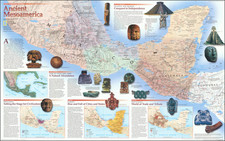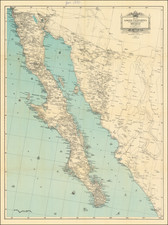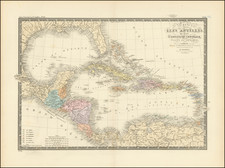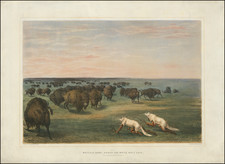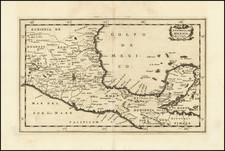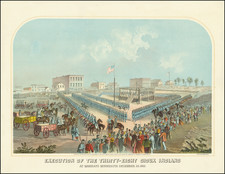Tlaloc, Mayahuel, Tezcatlipoca
An original ink and watercolor drawing of four Aztec deities, after the Codex Vaticanus, likely copied from Lord Kingsborough's Mexican Antiquities (vol. 2). This brilliantly colored watercolor was made by William H. Shippard in the 1830s.
The four deities depicted are well-known supernatural figures from the Aztec pantheon:
- Tlaloc (god of rain), a major deity who had his own cult. "Night Lord, patron of number 8, day sign Deer, and seventh trecena/Rain. Attributes: black face and body paint, turquoise eye goggles and curved lips, fanged mouth, rubber spattered paper on costume, blue costume" - Boone.
- Mayaguil [Mayahuel] (goddess of abundance). "Manifestation of maguey plant; patron of day sign Rabbit and eighth trecena/Grass. Attributes: curved nose ornament, maguey plant" - Boone.
- Xiuatlatl ["Turquoise Spear Thrower," possibly Xiuhtecuhtli, god of fire or war]
- Tezcatlipoca ("Smoking Mirror") "Patron of rulers and divination; patron of number 10. Attributes: black and yellow horizontally striped face paint, smoking mirror, red and white circular pectoral" - Boone.
Light pencil notes in Shippard's hand:
Cod. Vat. Vol. 2, Plate 28 / Cod. Vat. Vol. 2. Plate 29. ex. vol. 6
William Henry Shippard's Mexican Paintings
William H. Shippard (1803-1865) was a pioneering 19th-century British museologist - an unsung progenitor of modern-day museum anthropology. While he is chiefly remembered as a friend of George Catlin, Shippard's profound interest in the ancient civilizations of Mexico connects him with a cohort of British contemporaries that include Lord Kingsborough and the showman William Bullock. Shippard's fascination with Mesoamerica propelled him to amass a significant collection of visual material derived from Aztec codices which he copied himself. A figure of some intrigue and scholarly ambition, Shippard endeavored to establish the Museum of Mankind in London, which seems to have evolved from his deep interest in early Mexican cultures. Although the museum did not come to fruition, Shippard's original artwork, mainly pen and ink drawings enriched with vibrant hand coloring, based on Mexican codices held in European libraries and collections, remains a valuable historical source, particularly for understanding the allure of Mexican antiquity within early 19th-century British collecting circles.
Capt. William H. Shippard, a friend of George Catlin and an avid watercolorist and museologist, was also a pioneering British Mesoamericanist. Shippard appears in British newspaper notices from the 1840s as a London-based lecturer who spoke about Native Americans and Mexican antiquities. We know he was a friend of George Catlin, and that he was involved in attempts to organize early London museum exhibitions of Mexican antiquities. In the latter efforts Shippard would seem to coincide with a group of like minded prominent English collectors interested in Mexican topics active during the 1820s and 1830s, including Lord Kingsborough and the bibliomaniac Sir Thomas Phillipps, among others. He seems to have been an armchair anthropologist and would-be museum founder, whose ambitious ideas for a London-based museum never got off the ground - at least not beyond the prospectus-printing stage. Certain aspects of Shippard's career are akin to William Bullock, the showman and connoisseur of Mexican antiquities who actually did travel to Mexico. Bullock published a notable book about his Mexican travels, and achieved a level of recognition in his day as the empresario of London's Egyptian Hall, wherein he thrilled large London audiences with his elaborate exhibitions of exotica, including Mexican items.









